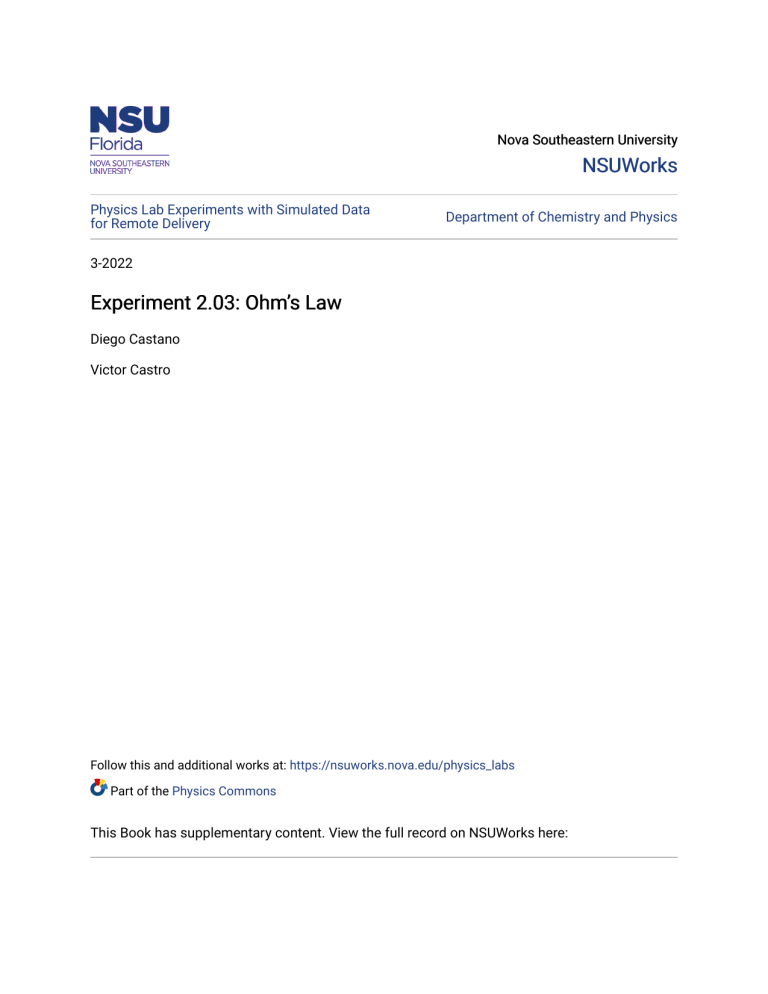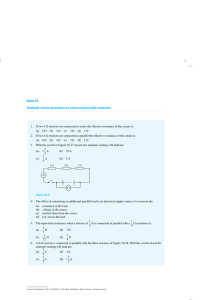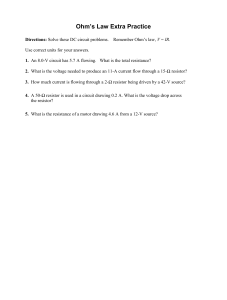
Nova Southeastern University NSUWorks Physics Lab Experiments with Simulated Data for Remote Delivery Department of Chemistry and Physics 3-2022 Experiment 2.03: Ohm’s Law Diego Castano Victor Castro Follow this and additional works at: https://nsuworks.nova.edu/physics_labs Part of the Physics Commons This Book has supplementary content. View the full record on NSUWorks here: I. EXPERIMENT 2.03: OHM’S LAW A. Abstract Ohm’s law is used to determine the resistance of several resistors. B. Formulas (1) V = IR , series Req = R1 + R2 + 1 1 1 = + + Req R1 R2 (2) , parallel (3) 10c3 (4) Resistor color codes: color no. black 0 brown 1 red 2 orange 3 yellow 4 green 5 blue 6 violet 7 gray 8 white 9 R = (10c1 + c2 ) where (c1 c2 c3 ) represents the resistor’s 3-color bands and R is the value of the resistance in Ohms. For example, Brown-Black-Brown corresponds to (1; 0; 1), therefore 10c1 + c2 = 10 and R = 10 101 = 100. 1 C. Description and Background In this experiment, you will become familiar to some standard equipment (ammeter and voltmeter). You will also learn how to build electric circuits with resistors and wires (Fig. 2). Then, you will learn how to measure the current through a wire, as well as the voltage between two points in a circuit. Finally, you will verify Ohm’s law. See Appendix I at the end of this document for important instructions on the use of multimeters. FIG. 1. (a) Flow of current from A to B through a resistor R. V is the potential di¤erence between points a and b. (b) Ohm’s law. As we learned in class, Georg Simon Ohm (1787-1854) established experimentally that the current, di¤erence I, ‡owing through a resistor (e.g., a metal wire) is proportional to the potential V applied to its two ends (points a and b in Fig. 1a). The magnitude of the electric current depends not only on the potential di¤erence but also on the resistance of the wire (see (b) in Fig. 1). We de…ne the electrical resistance, R, to be: R= V ; Ohm’s law I The unit for resistance is called the Ohm ( ). Resistors connected in series (Fig. 2b) have an equivalent resistance, Req , given by Eq. 2, while resistors in parallel (Fig. 2c) have an equivalent resistance given by Eq. 3. In both cases, the equivalent resistance draws a current I, such that V = IReq . Typical resistors have a four–color code (Fig. 3). From the …gure, the tolerance (colored line D) could be either silver (10%) or gold (5%); if there is no D–line it means that the tolerance is 20%. The value of the resistor is given by colored lines (see Table above) A = c1 , B = c2 , and C = c3 , according to Eq. 4. 2 FIG. 2. (a) A single resistor. (b) Resistors in series. (c) Resistors in parallel. The (A) and (V) indicate the ammeter and voltmeter, respectively. FIG. 3. Typical resistor with a 4-color code. For the resistor in the …gure, c1 = 3 for orange, c2 = 6 for blue, c3 = 2 for red, and D is gold. Using Eq. 4: R = (3 10 + 6) 102 = 3600 With a tolerance of: 3600 0:05 = 180 Thus the resistance is R = (3600 3 180) D. Procedure 1. Using the color codes in the Table, …nd the value of each of three resistors in the …gure below and record them. FIG. 4. From left to right R1 ; R2 ; and R3 . 2. For each of three resistors (resistance range: 150 includes the resistor and a variable emf source (E 560 ), set up a simple circuit that 5 V ). 3. Use a voltmeter to measure the voltage across the resistor and an ammeter to measure the current in the circuit. The ammeter should be set to measure milli-Amps. See Appendix I at the end of this document for important instructions on the use of multimeters. 4. Do as many trials as possible by varying the emf. 5. Connect the three resistors in series and repeat steps 2 through 4. 6. Connect the three resistors in parallel and repeat steps 2 through 4. 4 1. Figures FIG. 5. Single resistor. FIG. 6. Resistors in series. 5 FIG. 7. Di-Binding-Post Blocks in Series FIG. 8. Resistors in parallel. FIG. 9. Di-Binding-Post Blocks in Parallel 6 E. Measurements resistor 1 Trial I [ Amp ] 1 0 V [ V olt ] 0 resistor 1 colors 2 by the colors R1 [ 3 ] 4 5 resistor 2 Trial I [ Amp ] 1 0 V [ V olt ] 0 resistor 2 colors 2 by the colors R2 [ 3 ] 4 5 resistor 3 Trial I [ Amp ] 1 0 V [ V olt ] 0 resistor 3 colors 2 by the colors R3 [ 3 ] 4 5 resistors in series Trial I [ Amp ] 1 0 resistors in parallel V [ V olt ] 0 Trial I [ Amp ] 1 0 2 2 3 3 4 4 5 5 7 V [ V olt ] 0 F. Instructions 1. Use OhmsLawPlot.xlsx to make plots of determine the resistance from the slopes. 8 V vs. I in each of the …ve cases, and G. Calculations resistor(s) R [ ] based on the analysis R [ 1 2 3 series parallel 9 ] based on the colors % Di¤erence II. APPENDIX I A. Multimeters Multimeters are versatile electronic devices that can be used to measure properties such as voltage, current, and resistance. Multimeters typically employ two leads, one of which is always plugged into a socket labelled COM for common. The second lead is plugged into the socket appropriate to the function desired and usually labelled V (Volts) for voltage, mA, A, or 10A (Amps) for current (depending on the expected range), and (Ohms) for resistance. There is also a dial that turns the multimeter on and must be turned to the appropriate setting. There is a toggle key that will switch from DC to AC mode and a toggle key that can switch the numerical range of measurements. B. Voltmeters Voltmeters are nonintrusive to a circuit. The leads are used to probe the voltage between two points in the circuit. When using a voltmeter to measure the voltage across a circuit element, attach the leads (alligator clips) to both ends of the element under consideration. C. Ammeters Ammeters, unlike voltmeters, are intrusive to a circuit in that they must be inserted into the circuit segment whose current is to be measured. The circuit segment must therefore be broken and the ammeter placed in series with the other segment elements. When using the ammeter with the circuit spring board, lift one end of the resistor from the spring it is attached to and bridge the gap with the ammeter leads, i.e., attach one lead to the spring and the other lead to the free end of the resistor. When using the ammeter with the circuit breadboard, lift the end of the jumper wire depicted in the …gures (e.g., those in Experiments 2.02-2.04) by an open circle. Attach one lead to the free end of the jumper wire and the other lead to the exposed wire of the resistor on the same terminal strip (column in the …gures). The circuit should remain open until the ammeter is inserted. Once properly inserted, the ammeter is turned on. The circuit is then closed, and the current measurement taken. 10 Removal of the ammeter should proceed in reverse: The circuit is opened, then the ammeter is turned o¤ and removed. Failure to follow this procedure may result in damage to the ammeter. D. Ohmmeters An ohmmeter measures the resistance of whatever is connected between its two leads. Consequently, it is important that only those elements (or arrangement), whose resistance is sought, be positioned between the leads. This may require separating the arrangement of elements from the rest of the circuit to make the proper ohmmeter measurement. Case (a) in the …gure below depicts an example of a faulty ohmmeter measurement. The goal is to measure R1 , but this resistor is not the only element between the ohmmeter leads in case (a). The reading in case (a) would actually be R1 (R2 + R3 ) = (R1 + R2 + R3 ). In case (b) the resistor of interest is separated out and is the only element between the leads. FIG. 10. Example of improper and proper use of ohmmeter. 11







